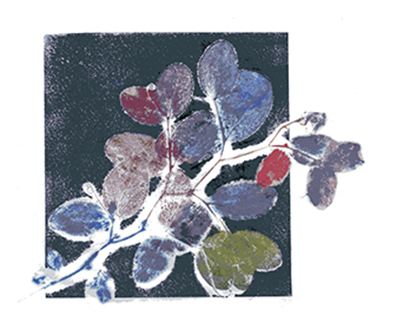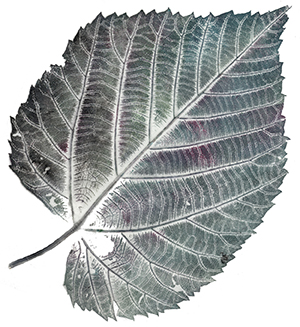My teacher, Sonja Larsen, is a master at creating interesting backgrounds for nature prints. In fact, there’s a six-page chapter and a two-page chapter on background techniques in the book Sonja and John Doughty co-authored. The book’s title is Creating Art From Nature.
One can paint, spray, drip, & fling watercolor paint onto dampened paper—Sumi-E/Oriental papers, printmaking, or watercolor papers—to create colorful backgrounds. Or, after spreading a watercolor wash onto the printmaking paper (this suggestion does not work well with the softer Oriental papers), place very flattened leaves onto the wash, or for a more geometric background pattern, place crumpled clear food wrap onto the painted, wet paper. Allow the paper to dry before dampening it in preparation for printing.
The print below is an example of flattened Cranesbill Geranium (Geraniaceae) leaves displacing the colorful background paint. The leaves created a pattern over which the Cranesbill Geranium plant was then printed.

Sometimes it’s fun to begin with a colorful background, place inked specimens on top of the inked background, and pull a print. The square shape was created by taping the shiny side of Reynold’s Freezer Paper in place to create a boundary to contain the strokes of the inked brayer. The image shown below is of my first monotype, made during Sonja Larsen’s 2007 nature printing workshop.
I found the twig on a walk in the woods that surrounded the now-closed family resort where about a dozen eager nature printers gathered to print and learn, celebrate the summer solstice, and have a memorable time.

When I’m demonstrating or teaching nature printing, I often caution people about becoming too exuberated. This condition, described here with a not-quite-official word, often results in brayers fastening to the ink on the palette as the printer enthusiastically pulls their print.
However, I, too, become exuberated; I’m eager to explore the patterns and colors on the palette before devoting time to discovering the beauty of printing a specimen in one or more ink colors.
I’m reminded of the print of the linden leaf shown below. The specimen grew as a sucker at the base of a neighborhood tree. Although the leaf’s diameter was similar to that of a dinner plate, I used a two-inch soft-rubber brayer to apply Speedball water-soluble printmaking ink with a very light touch. By rolling the brayer through a variety of inks on my palette, the brayer proved to be almost as expressive as a paintbrush.



